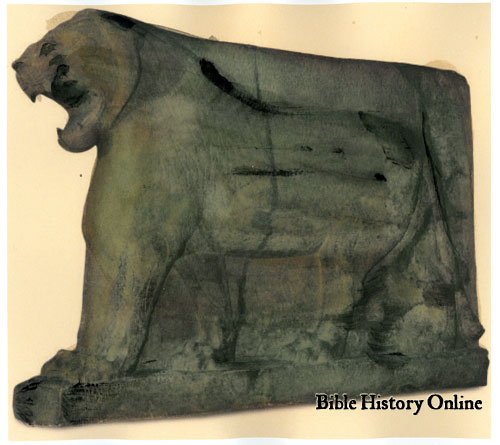
Could this 15-ton Lion of War have been carved with the destruction of Israel in mind?
Colossal Lion of Assyria

Could this 15-ton Lion of
War have been carved with the destruction of Israel in mind?
This gigantic roaring lion, once stood as part of a pair of lions at the entrance of an Assyrian temple dedicated to Ishtar, the goddess of warfare, and fertility.
The temple was adjoining the palace of King Ashurnasirpal II (reigned 883-859 BC. The temple was excavated by Henry Layard in 1849.
"...Where can we flee for help to be delivered from the king of Assyria: and how shall we escape?"
Isaiah 20:6
"He will raise a signal for a
nation from afar off, and whistle for it from the ends of the earth;
and lo, swiftly, speedily it comes."
Isaiah 5:26
Detailed Description of the Colossal Lion
Material - Limestone
Neo-Assyrian,
Reign of Ashurnasirpal II
Date: 883-859 BC
Width: 2.24 m
Height: 2.59 m
Nimrud (ancient Kalhu), northern Iraq
Excavated by: Henry Layard, 1849
Location: British Museum, London
Item: ANE 118895
Room: Room 6, Assyrian sculpture
British Museum Excerpt
Colossal statue of a lion
Guardian figure from the entrance to the Temple of Ishtar
This gigantic standing lion, roaring angrily, formed one of a pair carved half in the round which once flanked the entrance of a small temple dedicated to the goddess Ishtar, adjoining the palace of King Ashurnasirpal II (reigned 883-859 BC). The temple was excavated by Henry Layard in 1849.
The placing of figures of lions beside the doors of temples or the gates of cities was an ancient custom in Mesopotamia. Actual lions were common in the region and survived there until the nineteenth century.
The fifth leg is an artistic convention to enable the figure to be seen either from the side, walking, or from the front, standing. Compare this with the colossal statue of a winged human-headed bull from the palace of Ashurnasirpal II, also in The British Museum.
The lion is covered with a dedication in cuneiform, consisting of a prayer by Ashurnasirpal to a version of Ishtar called Sharrat-niphi, followed by a record of some of his achievements. Ishtar was one of the most important deities of Assyria. Here main cult centres were at Nineveh and Arbela. The lioness was her symbol as the goddess of fertility and warfare.
"The lion hath roared, who will not fear?" - Amos 3:8
Related Pages:
Head of a Roaring Lion - Assyria
Bible History Links - Biblical Archaeology : Assyria
Bible History Links - Ancient Near East : Art & Images 2
The
Striding Lion of Babylon
Archaeology of Ancient Assyria - Ancient Assyria
Bible History Links - Ancient Near East : Art & Images
HUNTING in
the Bible Encyclopedia - ISBE
International Standard Bible Encyclopedia - Calah
Assyria and Bible Prophecy - Nineveh Will Be Laid Waste
Bible History Links - Ancient Near East